The war in Syria has claimed more than 130,000 lives and, as these images reveal, it is also laying waste to its historic buildings and Unesco-listed sites.
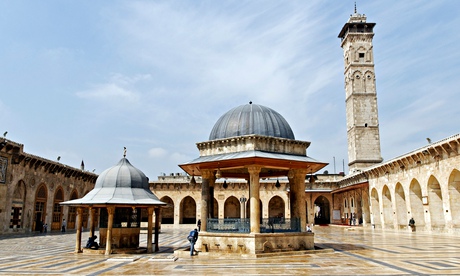
Umayyad mosque, Aleppo – pictured in 2012, before fighting destroyed it in 2013. Photograph: Alamy
They were sleepy tree-lined boulevards where people lived and worked, time-worn markets where they came to trade and exquisitely detailed mosques where, throughout the ages, they prayed.
All now stand in ruins, ravaged by a war that is not only killing generations of Syrians but also eradicating all around them, including sites that have stood since the dawn of civilisation. Across Syria, where a seemingly unstoppable war is about to enter a third year, a heritage built over 5,000 years or more is being steadily buried under rubble.
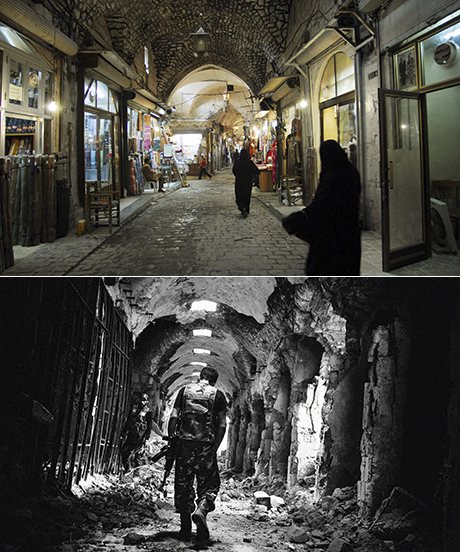 The Old Souk, Aleppo. Above in 2007 and below in 2013. Photographs: Corbis, Stanley Greene/Noor/Eyevine
The Old Souk, Aleppo. Above in 2007 and below in 2013. Photographs: Corbis, Stanley Greene/Noor/Eyevine
The destruction of towns and villages is regularly revealed by raw, and often revolting, videos uploaded to the web, which many people stopped watching long ago. Only seldomly do the shaky images reveal the damage being done beyond the battle – to ancient churches, stone Crusader fortresses and ruins that have stood firm during several millennia of insurrection and purge but are being withered away by this unforgiving war.
Syria's war has claimed more than 130,000 lives. At least two million of its citizens have fled into neighbouring states and more than two million others have been displaced within its borders. Industry and economy has long ground to a halt. Hope too has been on a relentless slide. Syria has six Unesco sites, representing at least 2,000 years of history. All have been damaged.
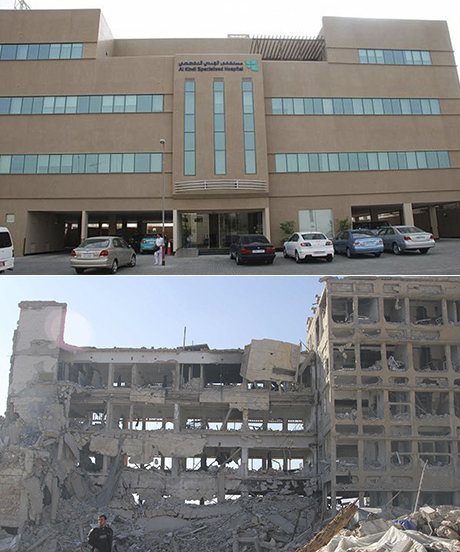 al-Kindi hospital, Aleppo. Above in 2012 and below in 2013. Photographs: Getty
al-Kindi hospital, Aleppo. Above in 2012 and below in 2013. Photographs: Getty
These before and after pictures show the old world order of Syria reflected for decades in history books; where people bought wares in marketplaces or mingled in mosque courtyards. They also reveal the shocking scale of devastation in all corners of the country and the damage done to Syria's soul and identity.
In Aleppo, one of the oldest covered marketplaces in the world is now in ruins; its maze of stone streets has been one of the most intense battlefields in the country for the past 18 months, bombed from above by air force jets and chipped away at ground level by close quarter battles that show no sentiment towards heritage. Those who dare raise their heads above the ruins, towards the ancient citadel that stands at the centre of the city, can also see damage to several of its walls.
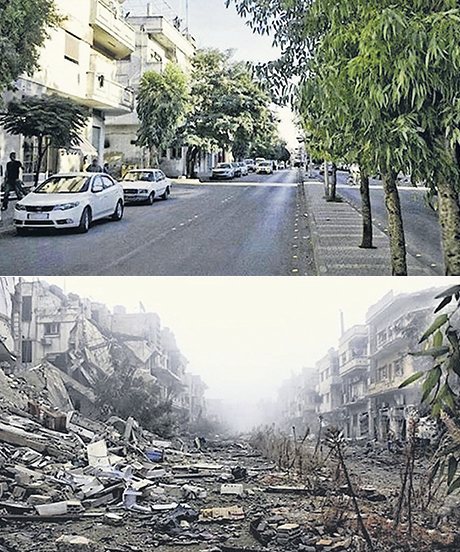 A street in Homs, in 2011 (above) and 2014 (below)
A street in Homs, in 2011 (above) and 2014 (below)
Several hundred miles south, just west of Syria's third city, Homs, one of the most important medieval castles in the world, Krak des Chevaliers, has taken an even heavier toll. Directly struck by shells fired from jets and artillery, the hilltop fortress now stands in partial ruin.
Homs itself has fared even worse. A residential street, where cars not long ago parked under gum trees, has been destroyed. Life has ceased to function all around this part of the city, as it has in much of the heartland of the country. In one shot, a destroyed tank stands in the centre of a street. The old minaret next to it has also been blown up. This photograph is thought to have been taken in the countryside near Hama, to the north of Homs. But it could just as easily encapsulate the damage done in parts of the capital, Damascus, or in towns and villages from Idlib in the north to Deraa in the south, where the first stirrings of insurrection in March 2011 sparked the war.
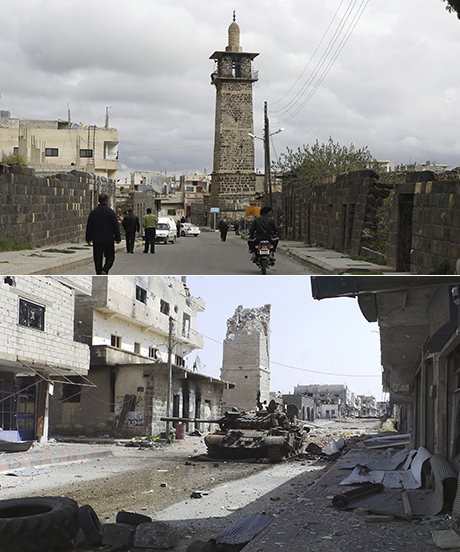 Omari mosque in Deraa. Above in 2011 and below in 2013. Photographs: Reuters
Omari mosque in Deraa. Above in 2011 and below in 2013. Photographs: Reuters
In May 2012, Emma Cunliffe, a Durham University PhD student, and member of the Global Heritage Network, prepared a report on the damage done to Syria's heritage sites, detailing the tapestry of civilisations that helped build contemporary Syria.
"Numerous bronze-age civilisations left their successive marks, including the Babylonians, the Assyrians and the Hittites," she said. "They, in turn, were replaced by the Greeks, the Sasanians, the Persians, the Romans and the Arabs, many of whom chose Syrian cities as their capitals. The European Crusaders came and left some of the most impressive castles known and the Ottoman Empire also made its mark. All these cultures co-existed and conflicted, forming something new and special and found nowhere else in the world."
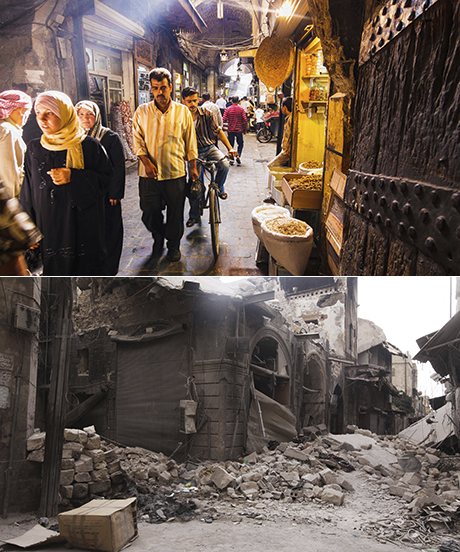 Souq Bab Antakya, Aleppo. Above in 2009 and below after an attack in 2012. Photographs: Alamy, Reuters
Souq Bab Antakya, Aleppo. Above in 2009 and below after an attack in 2012. Photographs: Alamy, Reuters
Speaking this week, she said the threat to Syria's heritage was now greater than ever. "Archaeological sites in Syria are often on the front lines of conflict and are experiencing heavy damage. Economic hardship and decreased security mean even sites away from the fighting are looted. This is denying not only Syrians but the world a rich heritage which can provide a source of income and inspiration in the future."
With little or no access to the country, satellite imagery is being used to track the destruction. The Global Heritage Fund's director of Global Projects, Dan Thompson said: "All of the country's world heritage sites have sustained damage, including the Unesco site cities, and a great many of the other monuments in the country have been damaged, destroyed or have been subject to severe looting.
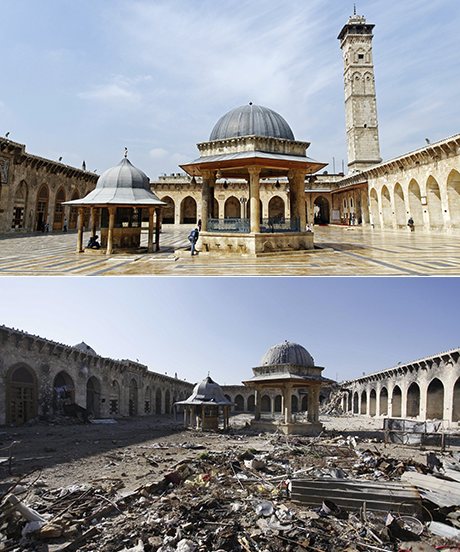 Umayyad mosque, Aleppo, pictured in 2012 (above) and 2013 (below). Photographs: Alamy, Corbis
Umayyad mosque, Aleppo, pictured in 2012 (above) and 2013 (below). Photographs: Alamy, Corbis
"Shelling, shooting, heavy machinery installed in sites, and major looting are the leading causes of damage and destruction to the sites, although I would not discount that vandalism is also playing a part. As far as we know, no concrete action is being taken to combat the damage in the present moment."
